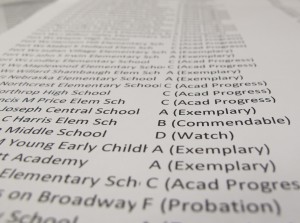Why Indiana's No Child Left Behind Waiver Won't Mean Less Reporting For The State
—Ross C. Santy, EdFacts director
Indiana and the 25 other states granted waivers from certain requirements of the federal No Child Left Behind law will still have to send student data to Washington, D.C., writes Sarah D. Sparks for Education Week:
That means waivers states, who have created brand new accountability systems, don’t have to do less reporting. They actually have to do more. All states, both waived and unwaived, must report the number and percentage of students in each subgroup, how many pass the reading/language arts and mathematics tests, the number who graduate high school with a standard diploma, and so on. In particular, unless a state specifically notes in its approved waiver that it will not use supplemental tutoring and school choice at schools identified for improvement, districts still must report how much money was spent on those services.
In fact, Sparks points out that some states — including Indiana — may have to do more reporting because their waivers divide students even further into groups or categories.
Indiana’s waiver creates a “super-subgroup” of students who score in the bottom 25 percent to ensure they’re making progress.
“Districts in these states will have to report the numbers and test performance of any combined student groups separately and in addition to reporting all of the standard student groups,” writes Sparks.Ross C. Santy, director of EdFacts, told state and district officials who attended a National Center for Education Statistics conference in Washington, D.C., last week they would still have to report student achievement data to receive federal funding, like Title I and school improvement grants. The Department of Education is tweaking how it collects and reviews this information because so many states have received waivers.
Vermont actually dropped its application for a waiver after learning schools couldn’t opt out of annual standardized testing.
Indiana’s waiver changes how the Department of Education calculates letter grades. Instead of looking purely at passage rates, schools will be evaluated based on how many students improved their performance on statewide standardized tests. The state will still have to report those scores to the federal education department.



